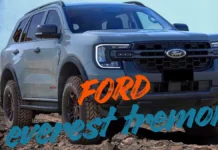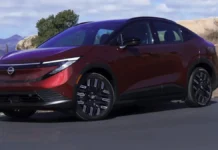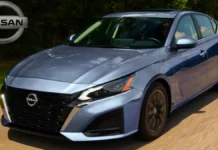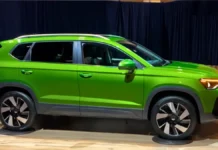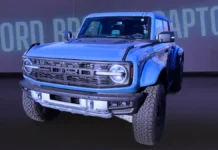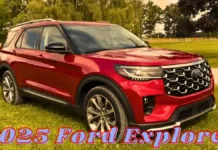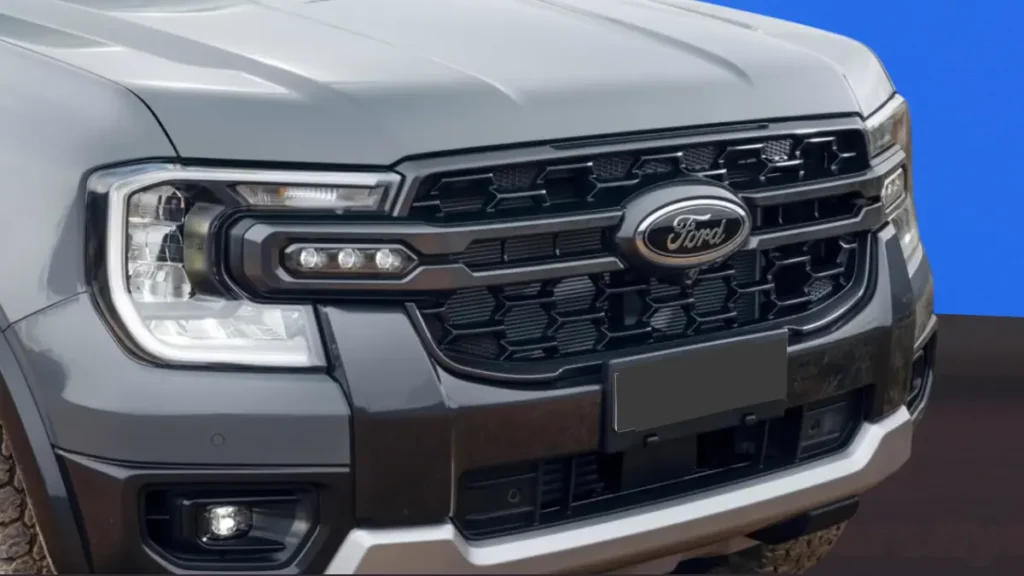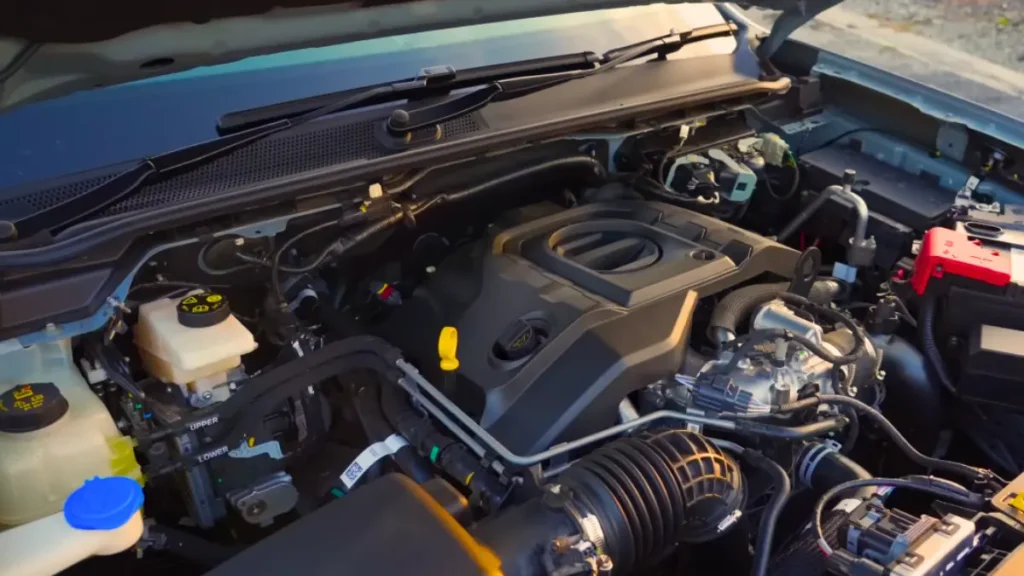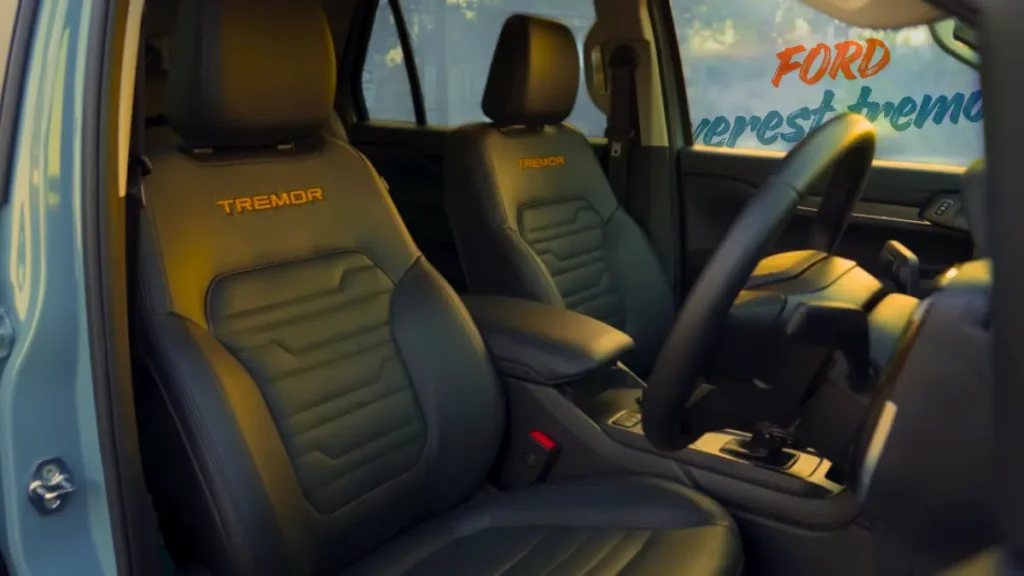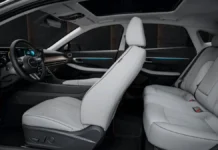Contents
- Overview
- Where This Vehicle Ranks
- What’s New for 2025?
- Pricing and Which One to Buy
- Engine, Transmission, and Performance
- 0–60-MPH Times
- Fuel Economy and Real-World MPG
- Interior, Comfort, and Cargo
- Safety and Driver-Assistance Features
- Warranty and Maintenance Coverage
- SPECIALISTS’ VERDICT ( Car and Driver , Edmunds , etc.)
- Final thoughts
- FAQs
Overview
The Ford Everest Tremor brings a new level of ruggedness to Ford’s midsize SUV lineup. Built to tackle rough trails, deep ruts and soft-sand beach runs, the Tremor variant adds hardware, software and styling that move the Everest away from family-hauler territory and toward serious off-road capability. If you’re searching for a four-wheel-drive SUV with body-on-frame durability, raised ride height and off-road-first tech — but that still serves as a daily driver — the Everest Tremor is designed for that middle ground.
This article explains where the Tremor sits in the Everest range, what’s new for 2025, pricing guidance, drivetrain and performance specs, real-world fuel economy, interior comfort, infotainment, safety, warranty coverage and how specialists view the package.
Where This Vehicle Ranks
The Ford Everest Tremor is the off-road-focused halo of the Everest model line. Think of it as the “trail-ready” version that sits above the standard XLT and Sport trims and parallel to any luxury-oriented Platinum-type models in markets where those are offered. Compared with the entry-level and midgrade Everest trims, the Tremor prioritizes:
- Off-road capability: locking differentials (where equipped), upgraded suspension tuning, enhanced climb/descent control and specific drive modes for rocks, mud and sand.
- Increased ground clearance and underbody protection: skid plates, reinforced bumpers and optimized approach/departure angles.
- Unique styling cues: Tremor badging, skid-plate accents, all-terrain tires on larger wheels, and a more aggressive front grille.
In the global Ford lineup, the Tremor-edition Everest competes with similarly tuned off-road variants such as the Toyota Fortuner Legender/Toyota Fortuner TRD Pro (in some regions), Mitsubishi Pajero Sport Rockford Fosgate or off-road-focused derivatives of the Isuzu MU-X. For buyers who value capability over pure luxury, the Tremor is often the right compromise — more competent off-road than a base Everest, but less tailored for highway refinement than top luxury trims.
What’s New for 2025?
For 2025 Ford refined the Everest Tremor to improve usability and off-road performance while keeping cabin comfort competitive. Key updates include:
- Revised suspension tuning: A retuned spring and damping setup offers a taller ride height and improved bump absorption for rocky terrain without sacrificing highway composure.
- Updated off-road drive modes: Enhanced Terrain Management software now offers finer control for sand and mud, better throttle mapping at low speeds and improved traction control logic for loose surfaces.
- Electronics upgrades: Faster-response hill descent control, and optional upgraded rear differential locker software for quicker engagement.
- Interior and tech tweaks: An updated infotainment interface with faster screens, wireless Apple CarPlay and Android Auto as standard, and optional cabin materials designed to resist mud and abrasion.
- Cosmetic changes: New Tremor-exclusive exterior colors, a redesigned grille option and updated skid-plate graphics that provide more functional airflow for cooler brakes during demanding off-road runs.
These updates harden the Tremor’s off-road credentials while making the model easier to live with as an everyday vehicle.
Pricing and Which One to Buy
Pricing for the Ford Everest Tremor varies by market and options but typically sits at a premium above the midrange Everest trims. As a guideline:
- Base Everest: Positioned as the budget family option.
- Mid trims (XLT/Sport): Offer the best value for general buyers who want comfort and some off-road ability.
- Tremor: A step above midrange in price; expect a significant premium for the off-road hardware and exclusive features.
- Top luxury trims: Higher price but focus on interior refinement rather than hardcore terrain capability.
Which one to buy? It depends on priorities:
- Buy the Tremor if you plan frequent off-road use, remote travel, or need the extra ground clearance and protective hardware. The Tremor is the practical choice for adventure travelers, outdoor professionals and rural drivers.
- Choose midrange trims if you want a balanced SUV with occasional dirt-road use but prioritize ride comfort, fuel efficiency and lower cost-of-ownership.
- Opt for higher-end luxury trims if you prioritize plush interiors, advanced driver assists and maximum on-road quietness rather than rugged capability.
Always factor in optional packages: heavy-duty tow packages, upgraded tires, underbody armor and optional rear lockers raise capability but also add cost. For most buyers looking for genuine off-road performance without excessive expenditure, the mid-level Tremor with the off-road pack checked is the sweet spot.
Engine, Transmission, and Performance
The Everest Tremor typically uses Ford’s proven turbodiesel engine options in markets outside North America, combined with a robust automatic transmission and 4×4 system. Typical specs (varies by region):
- Engine: 2.0L bi-turbo diesel or 3.0L V6 diesel (market dependent). The 2.0L bi-turbo is common for its blend of torque and efficiency.
- Output: 210–250 hp (157–186 kW) with torque figures in the 500–600 Nm range for the bi-turbo diesel; the V6 diesel can produce higher torque in select markets.
- Transmission: 10-speed automatic (in many regions) tuned for strong low-end torque delivery and smooth shifts under load.
- Driveline: Part-time or full-time 4WD with low-range gearing, electronic locking rear differential (on Tremor as standard or optional), and Terrain Management drive modes including Mud/Ruts, Sand, Rock Crawl and Eco.
Performance-wise, the Tremor’s modifications (lifted suspension, heavier underbody protection and off-road tires) add weight and slightly reduce on-road quickness versus a standard Everest. However, the Tremor’s drivetrain is calibrated to preserve strong low-speed torque for crawling and towing, while the transmission’s gear spread helps with highway cruising.
0–60-MPH Times
Because many markets offer different engines, 0–60-mph (0–97 km/h) times vary. Expect:
- 2.0L Bi-turbo diesel: Approximately 8.5–9.5 seconds in Tremor trim (est.), slightly slower than the lighter standard Everest due to added weight and more aggressive off-road tires.
- 3.0L V6 diesel (where available): Mid-to-high 7-second range depending on tune and conditions.
These times are competitive for a body-on-frame midsize SUV focused on torque and capability rather than outright acceleration. For buyers focused on off-road performance and towing, low-end torque and gearing are more relevant than the 0–60 sprint.
Fuel Economy and Real-World MPG
Real-world fuel economy for the Everest Tremor reflects the trade-offs of off-road hardware: increased weight, higher ride height, less aerodynamic styling and all-terrain tires. Typical economy:
- Combined cycle (manufacturer estimate): 25–30 mpg (US) equivalent for the 2.0L diesel in regions with efficient tuning — note: many official figures use local test cycles (WLTP, ADR, etc.), so reported numbers vary by region.
- Real-world driving: Expect 18–24 mpg (US) depending on driving style, load, and terrain. Highway driving with light load and moderate speeds improves economy; off-road usage, towing and heavy urban use reduce it.
For more information about the Everest Tremor‘s fuel economy, visit the EPA’s website.
Tips to improve fuel economy:
- Use cruise control for highway travel.
- Opt for highway-oriented tires if you rarely go off-road.
- Maintain tire pressures and follow scheduled maintenance for optimal engine performance.
- Remove unnecessary roof racks and cargo when not in use to reduce drag.
Interior, Comfort, and Cargo
The Tremor retains the Everest’s practical interior layout: three-row seating in many configurations, durable surfaces and cargo flexibility designed for both family duty and adventure gear.
Seating and comfort:
- Seating: Typical 7-seat layout (2-3-2) with optional 6-seat with captain’s chairs in the second row. Tremor models often get contrast stitching, special seat materials and washable panels in high-wear areas.
- Ride comfort: The off-road suspension is tuned to absorb trail impacts but remains compliant for daily driving. Expect slightly firmer ride feel than the softest on-road Everest trims.
- Noise: All-terrain tires produce more road noise than highway tires; Ford offsets this with targeted soundproofing but Tremor will be a bit louder at highway speeds.
Cargo:
- Behind the third row: Adequate for groceries or small gear.
- Folded seats: When second and third rows fold flat, cargo volume becomes substantial, suitable for large outdoor equipment and overland kits.
- Storage features: Tie-downs, underfloor compartments and roof-rail systems accommodate expedition accessories.
Infotainment and Connectivity
Ford modernized the Everest’s connectivity suite for 2025, improving responsiveness and standardizing smartphone integration.
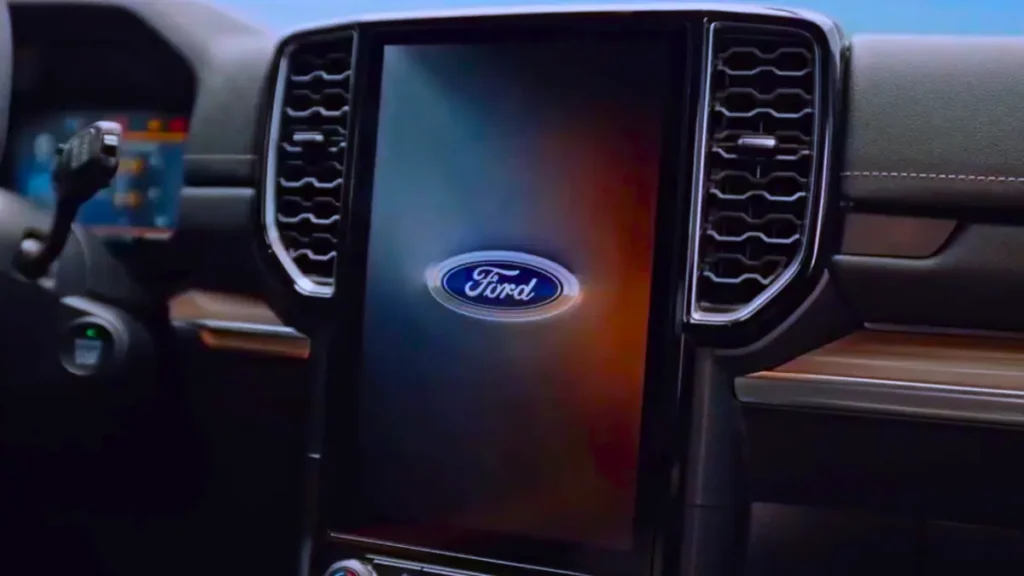
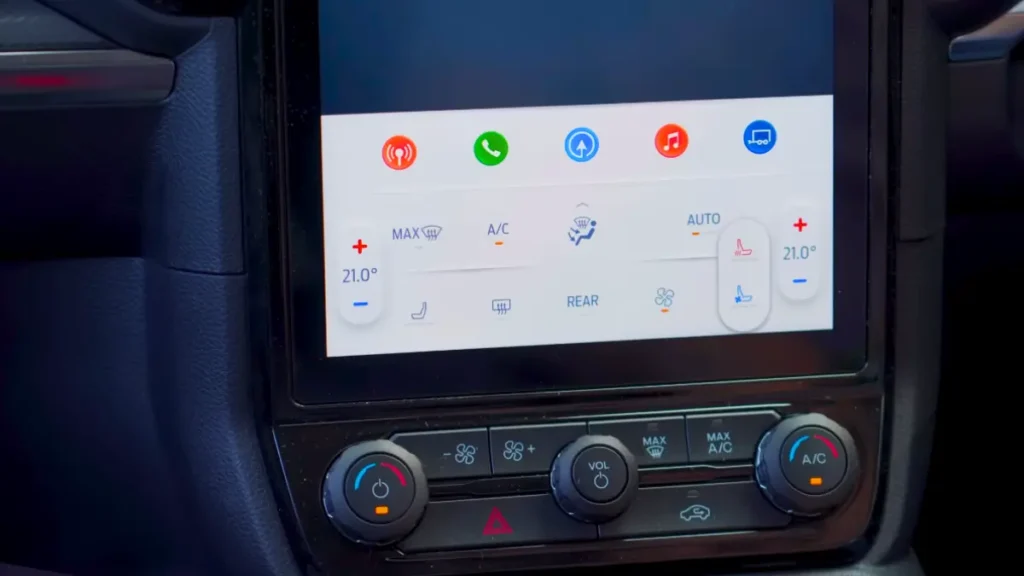
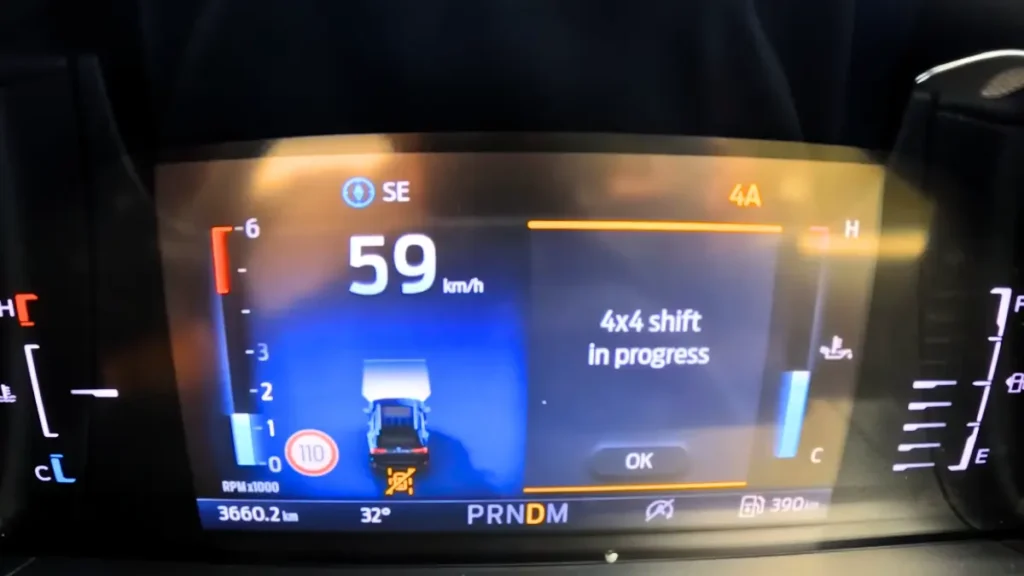
Key features:
- SYNC infotainment: Upgraded SYNC with a responsive 10–12-inch touchscreen (region-dependent), improved graphics and faster boot times.
- Wireless Apple CarPlay and Android Auto: Standard on Tremor to reduce cable clutter.
- Navigation and off-road maps: Optional built-in navigation includes off-road waypoint management and trail mapping where supported.
- Connectivity: Multiple USB-C ports, optional 4G/5G modem for connected services, Wi-Fi hotspot and OTA software updates for select modules.
- Audio: Standard mid-level sound system with optional premium system (B&O or region-specific brands) for better road and trail listening.
Safety and Driver-Assistance Features
Although primarily an off-road unit, the Tremor still includes a broad suite of safety systems to protect occupants on and off pavement.
Common safety features:
- Automatic emergency braking with pedestrian detection
- Lane-keeping assist and lane-centering on select markets
- Blind-spot monitoring with rear cross-traffic alert
- Adaptive cruise control with stop-and-go capability
- Rearview camera and surround-view camera system (handy for trail maneuvering)
- Post-collision brake assist and trailer sway control when equipped with tow package
Overall Safety Rating (NHTSA)
As of the 2025 update, a specific NHTSA overall rating for the Everest Tremor may not be separately published; ratings typically apply to the model line as a whole. The base Ford Everest has received solid crash protection in markets where it underwent testing, but the precise NHTSA rating can vary by configuration and region. For the most reliable safety data:
- Check the NHTSA or local safety authority database for the Everest model year you are considering.
- Verify whether the Tremor-specific equipment (e.g., lifted suspension, heavier bumpers) affects crash-test results or active-safety system performance in your region.
- Review independent crash-test and real-world safety reviews from ANCAP, Euro NCAP or regional bodies if available for your market.
Visit the National Highway Traffic Safety Administration (NHTSA) and Insurance Institute for Highway Safety (IIHS) websites.
Warranty and Maintenance Coverage
Warranty and maintenance programs are market-dependent, but typical Ford coverage includes:
- New-vehicle limited warranty: Commonly 3–5 years with mileage caps (e.g., 3 years/36,000 miles in some markets; 5 years/100,000 km in others).
- Powertrain warranty: Often longer than the bumper-to-bumper term (e.g., 5 years).
- Corrosion/perforation warranty and roadside assistance packages vary by region.
- Service plans: Ford often offers prepaid maintenance plans or scheduled maintenance packages as optional extras.
For buyers in remote or off-road use, consider extended warranty and specialized service plans that cover off-road-related repairs and higher wear items (suspension components, underbody protection, differential service).
SPECIALISTS’ VERDICT (Car and Driver, Edmunds, etc.)
Industry reviewers generally view the Ford Everest Tremor as a smart evolution of a proven SUV platform into a more capable off-road machine without sacrificing everyday usability.
- Strengths highlighted by specialists:
- Authentic off-road capability with practical, user-friendly systems.
- Strong low-end torque and durable drivetrain options, ideal for towing and trail work.
- Useful cabin versatility and thoughtful storage for adventure gear.
- Improved infotainment and connectivity for modern ownership.
- Weaknesses commonly noted:
- Heavier weight and less aerodynamic profile reduce fuel economy versus non-Tremor trims.
- All-terrain tires and lift can increase road noise and slightly degrade on-road agility.
- Pricing can climb quickly with optional off-road and comfort packages.
Overall specialist consensus: The Ford Everest Tremor is recommended for buyers who will make regular use of its off-road features — whether that’s weekend overlanding, remote job sites, or family trips where rough roads are common. If your driving is overwhelmingly urban or highway-focused, a midgrade Everest trim with highway-oriented tires may deliver better value.
Final thoughts
The Ford Everest Tremor is a credible off-road SUV that bridges the gap between everyday usability and serious trail capability. For outdoor enthusiasts, rural professionals and expedition buyers, it’s a compelling package — combining proven Ford diesel torque, purposeful off-road systems and real cargo flexibility. As always, match trim, options and tires to your intended use, and review local specifications, warranties and safety ratings for the precise model and market year you plan to buy.
FAQs
The Ford Everest Tremor is the off-road–focused variant of the Ford Everest midsize SUV, featuring upgraded suspension, all-terrain tires, underbody protection, unique styling and enhanced Terrain Management driving modes for serious off-pavement use.
Key differences include higher ground clearance, off-road-tuned suspension, skid plates, aggressive all-terrain tires, Tremor-specific exterior and interior trim, and often an electronic rear differential locker and specialized drive modes that the standard Everest doesn’t include.
Depending on the market, the Tremor commonly uses Ford’s 2.0L bi-turbo diesel (popular for its torque/efficiency balance) and in some regions a 3.0L diesel V6. Exact availability and tuning differ by country.
Yes. The Tremor is designed to remain comfortable for everyday use while providing superior off-road capability. Expect a firmer ride and slightly more road noise from all-terrain tires compared with highway-focused trims.
Official figures vary by region and engine, but real-world combined fuel economy typically ranges lower than the standard Everest due to added weight and tires—expect roughly 18–24 mpg (US) under mixed driving conditions for the common 2.0L diesel Tremor setup.
Many Tremor packages include an electronic rear diff locker as standard or optional equipment. Availability depends on market and trim choice.

